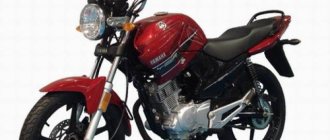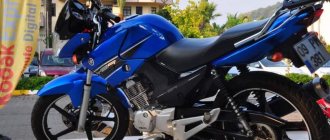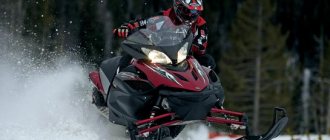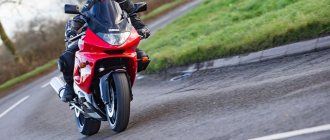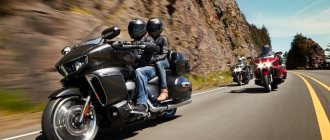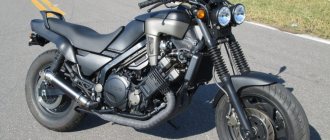What tires are suitable for YBR 125
Until 2008, motorcycles had three-spoke wheels with tube tires. Since 2009, five-spoke wheels have been introduced for tubeless tires.
Standard tire sizes:
- Front - 2.75-18
- Rear - 90/90-18
Tubeless tires are marked TL (tubeless), tube tires are marked TT (tube tire). Their difference lies in the presence or absence of a sealing layer. Tubeless tires can be used with a tube; on the contrary, with rare exceptions, you shouldn’t - air can leak through the tire itself. Many people try to install wider tires, however, this action is not entirely advisable, since it worsens handling, acceleration, reduces maximum speed and increases fuel consumption. The maximum possible tire size is listed below.
Maximum possible tire sizes:
- Front - 90/90x18 (but some models can rub. For example, toothy off-road tires are guaranteed to rub, or even not fit at all)
- Rear 110/90x18 or 130/70x18 (some models may also rub or may require bending the rear brake rod)
Firstly, due to the greater mass of the wheel, dynamics are noticeably lost. Some people's top speed drops. There were cases when even 4.0 toothy tires were installed back. Secondly, factory performance characteristics are violated. The motorcycle rides a little differently. Thirdly, given that the mass of the motorcycle will not change, it will also continue to be thrown around on the cut asphalt. It will also bounce on bumps. In short, it’s not so much the tires that are to blame, but the mass. Fourthly, on good tires, the size of which will correspond to the factory values, you can easily load the motorcycle up to the pegs (provided that the asphalt is clean and the instinct of self-preservation is temporarily disabled or absent)
Which tires to choose?
Here are some tips for choosing tires:
OFF-ROAD TIRES Among the very inexpensive ones, models L-333, L-328, L-251, K-102 have also proven themselves very well. The quality of this rubber is not high, so it often has problems with balancing and is even visually crooked, although according to reviews they are now making it a little better. However, if you plan to drive faster than 80 kilometers per hour on asphalt, look at other options. Among the more expensive ones, models K-270 and K-760 are also praised.
RUBBER FOR ASPHALT The leader among manufacturers of rubber for motorcycles is the French company Michelin. For the YBR 125, their product line includes the "Pilot Street" and "Pilot Activ" models. At the time of writing (06.2017) it is very difficult to call some tires budget, and some premium, because after the rise in price of the dollar, a situation has arisen where the same Pirelli, which before the crisis was 2 times cheaper than Michelin, now costs twice as much expensive. The same is true with metzeller products. Their tires are very popular among owners of this motorcycle, namely the ME22 model. Despite the fact that it is positioned as tube rubber, it can be safely used without a tube. The ME77 model is also good, despite the retro-style tread pattern, it holds the motorcycle perfectly on dry and wet asphalt. Despite the fact that the YBR 125 is not the fastest motorcycle, it can still hydroplane, so always choose tires with a developed deep tread.
Related Posts
How to protect your motorcycle from theft?
What to do if there is a motorcycle accident
Cleaning your motorcycle and equipment
Regal Raptor 50cc moped review
Winter motorcycle storage
Closing the circletext from Motorreview No. 11, 2005:
Mikhail Lapshin,
photo:
Dmitry Ivaikin
Yamaha YBR125: 123.7 cc, 12 hp, 110 km/h, $1990
April 28 – October 11, 2005, mileage
8500 km
For YBR, the past month of operation turned out to be difficult. I had to put a lot of kilometers on my wheels and be in the shoes of a motorcycle for beginners, and this is a double load.
I admit that when at the beginning of the season I decided to take the Chinese Yamaha for long-term testing, I thought that I would have to write a lot of negative things about the problems and breakdowns that arose. But in reality it turned out that there was nothing. After just a couple of months, I believed in him, like in any “Japanese”, which, as a rule, are created for driving, and not for tinkering with hardware. No matter how much you mocked the motorcycle (if you really want to, you can endurve it) on the motorcycle, no matter how much you abused the chassis (it happened that three of us rode together) and the engine (spin into the red zone happens often), but the YBR stoically withstood everything. The only thing is that the chain has stretched out a little (if I were the owners, I would have installed an o-ring here and forgotten about this unit), and the rubber bands of the footrests had become frayed. Agree, this is mere nonsense given such unbridled exploitation. And this month, new ones were added to the general permanent loads - the motorcycle played the role of a training bike for almost a week. Local boys, who had long looked after me with envy and hung out next to the garage, learned to ride it under my strict control.
Don't guess what I'm getting at? That's right! What do they teach in our motorcycle schools now? All the same ancient “Izhi” and “Kovrovtsy”. You can’t teach on something that essentially cannot move and is morally obsolete. I believe that very soon this entire fleet of motorcycles will be replaced by the YBR125. Firstly, for such schools the cost of the car is quite reasonable, and secondly, it is best to study on such a classic. I saw this with my own eyes. Almost all of my “students” who had initial skills in driving at least a bicycle, literally took off smoothly the second time and rode right away. Some even managed to change gears right away and brake quite confidently without any skidding or falling. The dimensions and weight of the Yamaha are such that any schoolchild can handle the motorcycle, and in the event of a fall (this has happened) practically nothing on the device is damaged, especially if the training is carried out on a grass field. According to many guys, control does not require much physical effort. And the engine thrust simply seemed like a rocket to them. But the main conclusion that I made for myself after this kind of master class for juniors is that Yamaha has a very positive effect on young people in terms of their further development of motorcycle preferences. For many, it was a real revelation that a motorcycle is not a dangerous bucket of nuts, but a thing that brings joy. The children have new guidelines. And the two oldest are already “terrorizing” their parents with all their might to buy this Yamaha. So on the YBR125, free entry into the motorcycle world is guaranteed.
As for me, a comparative test with a Kaliningrad classmate, and the mileage along the route Moscow - St. Petersburg - Moscow (read about this in the upcoming issues) once again confirmed confidence in the reliability and unpretentiousness of this budget model. It will definitely conquer the market.
Autumn, time to take stock of this amazing season. Why amazing? Editorial tests of the Chinese Yamaha turned even the most inveterate pessimists and skeptics into shining optimists.
I admit, I had absolutely no idea that the long-term tests of this budget foreign car would turn out to be so unexpected in terms of the final results and various promotions. Not only did the device have to put a lot of “ke-me” on its wheels under my leadership, but it was also in the skin of bait for motorcycle thieves, covered the route Moscow - St. Petersburg - Moscow paired with its Kaliningrad brother, and, most importantly , our employee managed to meet the Iron Butt standard on it... In any case, all this together led to a solid figure for the total mileage, and therefore to deeper and more balanced conclusions.
To the eternal question of the curious, “how’s the device?” I always answer confidently – excellent! Indeed, Yamaha can be given an “A” for the work done. Well, maybe with a small minus. I can already hear the angry roar of readers: “Yes, the R1 has a lot of minuses, but here this little guy gets the highest scores.” Yes, I bet. Naturally, with an eye on the class and market segment for which it is intended. Over the entire season, not a single incident happened to the car, much less a breakdown. Unless the clutch “ended” at the end of the season. However, the loads on this unit cannot be called normal, because the clutch was “tortured” by a whole team of boys when they were learning to ride a YBR, and then the device was also driven onto a cross-country track, then into the mud... In general, these are not at all normal conditions for road vehicles.
The high rating consists, first of all, of such qualities as efficiency, unpretentiousness, reliability, comfort, plus an amazingly low price. During normal use on highways and country roads, YBR consumes no more than 4 l/100 km. Moreover, changing fuel from AI-95 to AI-92 does not in any way affect the dynamics or operation of the power unit. If you drive slowly (80–90 km/h is cruising speed), then your appetite becomes even smaller. Oil consumption has not yet been observed, and this despite the fact that every now and then the engine had to be revved up to the red zone. At first I didn't like the brakes. But now I won’t be so categorical. There is no fuss, the effort can be measured clearly. What else does? Of course, emergency decelerations from “maximum speed” in traffic on the Moscow Ring Road, for example, did not become the best memories, but these are already quite extreme modes.
There are no questions about the power unit either. He rustles and rustles. In addition, in terms of access in case of repair or maintenance, everything is in full view here. A typical Yamaha “disease” - unclear operation of the gearbox - was also present at first. Now I can say that the patient is completely healthy - neutral is easily caught, shifting gears does not cause nervous twitching of the toe of the motorboat. Although size 45 is frankly a bit cramped on these footrests.
Finishing the conversation from the transmission, it is worth going through a unit such as a chain. It's a pity, it's a pity that she's just so ordinary here. No matter how you look after them, in our 8,500 km they have already replaced two. The O-ring would have lasted much longer. However, this would certainly lead to an increase in the price of the device. So advice to potential owners - as soon as the stock one is stretched to its limit, replace it with an O-ring chain.
From the outside, the light optics inspire respect, but in reality, the factory headlight settings only illuminate the clouds. Redirecting the light beam onto the road surface is not so easy. I had to disassemble the fairing and adjust the “angle of attack” of the diffuser. But this is the only time I had to adjust something on the motorcycle. Although I’m lying... Raising the idle speed with the adjusting screw on the carburetor is simply necessary - in the basic setting there is simply none.
The Russian road mentality has revealed several more nuances. The device looks quite presentable on the road (after all, the fact that it was decided to import the version with a mini-fairing was a wise decision), and it is not surprising that motorists are clearing the lane. But as soon as they realize what kind of miracle has overtaken them, the reverse process begins. Fortunately, any car can operate at speeds higher than the YBR, for which 120 km/h on the speedometer is the limit. The bicycle rear wheel especially let us down in terms of external aesthetics. A thicker “donut” just begs to come here.
There’s another problem in traffic jams – Yamaha drivers can’t hear! And this despite the fact that the “herring” nature of the motorcycle allows you to squeeze into gaps where even a person would have difficulty getting through. And there is a high probability of visiting some motorist if he happily opens the door, emptying out the ashtray. I can’t even resist advising to install a “direct flow”. Although…
So what happens? It must be said with all responsibility that the Russian motor market has finally received a budget product at the disposal of the masses with full compliance between price and quality. It is quite obvious that for that kind of money you cannot buy anything better new in Russia. And don’t forget that dealers offer excellent service, a guarantee and the possibility of purchasing on credit. With such an arrangement of stars in the sky, a bestseller is always born, and I will not be surprised that by the end of this year it is the Yamaha YBR125 that will break all sales records.
Into the dirt!
text:
Mikhail Lapshin,
photo:
Dmitry Ivaikin
Yamaha YBR125:
This time the device has only driven 700 km on its wheels, but what... Not many road motorcycles manage to experience the skin of a light enduro.
Tired of it! Frankly tired of making circles on the asphalt roads around the dacha, I looked for all the routes, went in the area even to places I didn’t want to go. Of course, the range of action was limited to a distance of no more than 100 km, but no one listed the YBR125 as a touring motorcycle. Long routes, as you understand, are tiring. Keeping the gas on full and seeing 120 km/h on the speedometer - not everyone can handle it. Especially when you are constantly being overtaken by cars. It's time to do something more exciting. And one fine day, instead of taking the usual route onto the nearest highway, I turned in the other direction, onto a path barely visible in the grass to the nearest forest. And already in the first meters of the journey, when I almost flew into an overgrown ravine, I realized that this activity was much more exciting than cutting across the asphalt.
I agree with the reader who at this point will mutter harmfully, saying, where are you going, the car is not intended for such purposes, it’s not intended to be broken... There are no objections, but haven’t any of you ever driven onto the ground on a road bike? And given the fact that the YBR125 is often bought as a vehicle for a summer residence, it is very likely that it will be used not only in civilian conditions. In general, this month Yamaha learned the routes of all forest paths, got used to jumping over fallen tree trunks, tasted all the delights of falling on soft grassy soil, and, of course, mud baths in numerous puddles.
There is only one conclusion – a collective farmer’s dream. The YBR125 easily digests the paths of the Russian outback. The soft suspension does not make it particularly difficult to handle small irregularities, such as roots protruding from the ground, and generally creates a feeling of comfort while driving. Only on large holes or bumps does the front telescope break through. I made the rear shock absorbers harder to make cornering on the gas more precise with slight wheel drift. The dry weight of the car is almost 100 kg, so you understand that even in difficult situations, when, for example, the path is blocked by a fallen tree, this “carcass” can be carried by hand. This same quality is good when crossing mud ravines or falling.
The standard tires are frankly not suitable for such operating modes. As soon as the soil swells a little from rain or heavy dew, a little braking with the front disc brake leads to the wheel skidding with a high probability of falling. The only thing that saves you in this situation is to have your legs pointed to the sides and a firm grip on the steering wheel - it’s not difficult to hold a light car at low speed.
By the way, in the wilderness I discovered another interesting quality of the device: the motor runs amazingly quietly. You can’t hear it even from a distance of ten meters, and sometimes it was surprising to find a hare or squirrel running away almost from under the wheels. That's what four-stroke means! The latter demonstrated decent elasticity, despite the modest working volume. In such conditions, only the second and third stages of the gearbox can be operated.
Super offer
text from Motorreview 2005:
Mikhail Lapshin,
photo:
Dmitry Ivaikin
Yamaha YBR125: 123.7 cm3, 12 l. pp., 100 km/h, $1990, April 28 - May 10, mileage 800 km
There is no doubt that the Japanese company Yamaha will soon become the most popular motorcycle brand in Russia. In this case, its main “combat unit” is the classic YBR125.
I admit, when I tested this model for the first time a year ago (“Motoreview” No. 6, 2004), I experienced ambivalent feelings about owning this motorcycle. On the one hand, I paid tribute to the wisdom of Japanese and, of course, Russian marketers who carried out such a correct and, I admit, at first somewhat unprofitable market move in terms of promoting this model. Just think: less than $2000 for a new foreign car, and even under the Yamaha brand! People, accustomed to the fact that “Japanese” cars cost well for $10,000, simply marveled at how this was possible. Yes, it is possible if you think globally about the sales market, and not see Russia as a country with no prospects in terms of the motorcycle business.
On the other hand, knowing the Russian mentality in terms of servility to large cubic capacity and power in the form of sportbikes with choppers, doubts crept in about the possibility of assimilation of this product under the name YBR125 in large quantities. But time has set its own accents. Last year, Russian Yamaha dealers sold a trial batch of these devices in the amount of 50 units instantly and received applications for almost ten times that amount. Therefore, this season the plans are generally Napoleonic - to implement 1000 cars. Actually, this fact served as the impetus for receiving YBR125 for long-term editorial testing. I would like to understand how the price corresponds to the build quality (the model is assembled in China on the official Yamaha assembly line), whether the device is reliable in terms of long-term operation, and in general, how successfully one can move around in the city and beyond. In general, there are a lot of questions and only seasonal tests can answer them.
From the outside, the YBR125 looks nice. And all thanks to the miniature half-fairing, which significantly updates the overall classic look. And the “two-glass” instrument panel with a dial indicator of the fuel level in the tank (a useful little thing!) significantly improves the first impression of the motorcycle. Not bad, very good. The Koreans and Chinese generally present a miserable package for that kind of money. And here there is even an electric starter. Of course, it’s stupid to think that now the device will “fly” like a “400”, but the first kilometers of the journey do not disappoint at all. Somehow your racing ambitions are immediately deflated, and the manner of driving motorists out of the lane by flashing your headlights is forgotten like a bad dream, and you begin to move sedately, moderately dynamically, along the two right lanes. Sometimes in these places you come across scooter riders who - thank God! - can't stand the competition. By the way, from the outside, only advanced motorcyclists are able to accurately determine the displacement of the engine, but if you stick a miniature YBR125 inscription under the saddle, you can easily pass off the model as a 250.
In first gear you can “squeeze out” 40 km/h, but at the same time the tachometer needle “grazes” almost in the red zone - 10,000 rpm. The engine groans and quickly loses traction at the top. Each subsequent gear to the red zone accelerates by another 20 km/h. So, you can easily reach 80 km/h, but to reach the maximum speed, 100 km/h according to the speedometer, you still need to accelerate and accelerate. Moreover, fifth gear is generally for driving downhill - the motorcycle practically does not accelerate in it. Well, unless, of course, the wind helps...
The pendants left a good impression. Since the device does not provoke extreme driving, you perceive their softness and comfort as a normal continuation of the general concept. It’s no secret what the capital’s roads look like in the spring, and it should be noted that it was only at the entrance to my dacha that I first began to think about what was under the wheels. The shock absorbers “eat up” potholes and broken seams in the asphalt perfectly. Naturally, the other side of the coin is the amorphousness and flimsiness of the chassis. This is especially noticeable during sudden lane changes and cornering. However, you shouldn’t ride the YBR125 with daring: the quieter you go, the further you will go.
These first hundreds of kilometers were driven mainly on country roads, driving along forest paths around the dacha and on dirt roads. I was pleased with the car. The YBR125 is definitely better than a scooter, and quieter in terms of power compared to used mid-sized Japanese ones. And obviously the still new appearance with a catchy inscription on the tank “Yamaha” inspires respect among the villagers. They are confident that it is at least a 500cc motorcycle. It’s a pity that you can’t get away from the annoying boys using straight-through chisels. During one of these competitions, a crazy idea came to my mind: what would happen to the YBR125 if you put an empty “muffler” on it? How much noise and respect! Well, I’ll tell you about this and other observations in the next report...
Parameters
Model _
| Yamaha YBR 125 | |
| Dry weight | 106 kg |
| dimensions | 1980´745´1050 mm |
| Base | 1290 mm |
| Seat height | 780 mm |
| Ground clearance | 175 mm |
| Gas tank volume | 13 l |
| Front fork tilt | n. d. |
| Engine | 123.7 cm3, 4-stroke, 1-cylinder, SOHC, 2-valve, air cooled |
| Engine size | 57/48.8 mm |
| Supply system | Mikuni carburetor |
| Compression ratio | 10,0 |
| Power | 12.5 l. With. at 8000 rpm |
| Torque | 9.5 Nm at 6500 rpm |
| Transmission | 5-speed gearbox, chain |
| Frame | steel, spinal |
| Front suspension | telescopic Æ30 mm, stroke - n. d. mm |
| Rear suspension | pendulum, two shock absorbers, stroke - n. d. mm |
| Front brake | one disc Æ150 mm, 1-piston caliper |
| Rear brake | drum |
| Front wheel | 2,75-18 |
| Rear wheel | 9,0/90-18 |
| Maximum speed | 100 km/h |
| Acceleration 0—100 km/h | 25 s |
| Fuel consumption | 3—5 l/100 km |
About the advantages and disadvantages of YAMAHA YBR125
Hi all. I decided to make an addition about my first motorcycle. I remembered some nuances that were not mentioned in the review. There are positive moments, there are negative ones, and there are ambiguous ones. I probably won’t systematize it. I'll cram everything into one big list. So:
1. The light is bad. Near and far are practically no different, in the sense that both modes work frankly weakly. Can't see a damn thing. One could assume that the headlight was incorrectly adjusted, but this is unlikely, because all other pre-sale preparation was carried out by the masters of the Panauto-Yamaha salon very efficiently and conscientiously.
2. The footrests do not fold - this has both pros and cons. On the one hand, strong, tightly welded footpegs, in the event of a fall, protect the engine cover, brake levers and gearbox, as well as the pilot’s legs from damage (which is doubly nice). On the other hand, experienced bikers say that after a couple of serious falls, such footrests can bend and the ride becomes uncomfortable.
3. The maximum load on the trunk according to the instructions is only 3 kg. I bought a case, installed it on the trunk, opened it, and I saw a sticker inside: 3kg, 120km/h. An interesting coincidence. Both the trunk and the trunk are designed for the same load, and 120 km/h is exactly the maximum speed that I managed to squeeze out of this device on a long descent, while being in the aerodynamic bag of a large jeep. Whether to exceed the permissible load limit or not to exceed it is up to everyone to decide for themselves. If necessary, I repeatedly seriously overloaded the trunk, but at such moments I tried to drive more carefully than usual, slowly and smoothly overcoming bumps so that nothing would come off.
4. By the middle of the second season I noticed that I was constantly driving at full throttle. In fact, with increasing experience, the lack of power begins to be felt not only on the highway, but also in the city. The motorcycle begins to seem sluggish and unhurried. I can’t call this a disadvantage, because I believe that adequate requirements must be placed on any technology. It is foolish to expect the dynamics of a sportbike from a 125 cc motorcycle, but the fact remains: by the end of the second season, the owner of such a device will probably want to switch to something more powerful.
5. I would like to note the leisurely wear and tear of consumables on this motorcycle. After 17 thousand kilometers, the chain and sprockets are in good condition, and will probably last at least until 25 thousand. But the rear tire and rear brake pads already require replacement. The wear on the rear cylinder is critical, but for such a mileage this is the norm. But the pads, on the contrary, surprised me. I expected them to last longer, but I can't put off replacing them. When braking with the rear circuit, a strong grinding noise is heard, and there is practically no deceleration. Most likely, this is due to my driving style: rarely using the front brake only in critical situations, jerky movement with constant acceleration and braking between the rows and, as the great Freddie Spencer taught, using the rear brake in a turn to tuck the motorcycle into the desired trajectory.
6. The standard installed Chinese tubeless tires pleased me with their good puncture resistance. During the entire period of operation I encountered this problem only once. I noticed that the pressure in the rear wheel had dropped, found a self-tapping screw sticking out of the tire, screwed it in deeper and made it to the tire shop without any problems.
7. By the way, the tires are quite narrow: 80 mm in the front and 90 in the rear. For this reason, the motorcycle behaves extremely unstable on poor road surfaces, for example on sections of removed asphalt. It makes sense to replace the cylinders with wider ones after wear. It’s realistic to put 110mm back. Forward 90. A nice bonus - with thick wheels the motorcycle looks much more serious.
8. I was very pleased that in rainy weather the pilot does not get a waterfall of splashes from under his own wheels. Developed volumetric wings reliably cut off flows of water raised from deep puddles by the tire tread. A small portion of dirt only ends up on the toes of the shoes.
9. The maximum speed of a motorcycle depends greatly on the terrain, and even more strongly on the direction of the wind. A headwind and a steep climb can seriously slow down the bike, despite the throttle being fully open. A tailwind and a descent, on the contrary, give the motorcycle amazing lightness and suspiciously playful dynamics. But this is due to the fact that I am large, and my aerodynamic characteristics are lousy. A more compact pilot will most likely not feel such a strong influence of these factors on the behavior of the motorcycle.
10. A strong side wind introduces downright dangerous instability into the behavior of the motorcycle. You have to hold the steering wheel tightly so as not to accidentally end up in the next row after another rush. The same problems arise when passing oncoming traffic with large trucks and buses. This is due to the low weight of the motorcycle - only 126 kg.
11. The seat is large and flat - like a sofa. Riding together is unexpectedly comfortable. It’s not at all cramped and there’s room to fidget to stretch your butt on the go on a long journey. It’s even more convenient for one. However, due to the overly simple profile of the seat, on long-distance trips, approximately every 100 km of the road, an irresistible desire arises to stop and do 50 squats.
12. They say that even a liter changes its character when driving with the second number. I don’t know about the liter, but 125 cubes, after the passenger boards, changes like heaven and earth. Under double load, the motorcycle becomes completely sluggish and smooth. Acceleration dynamics deteriorate, maximum speed drops, and fuel consumption increases. When systematically driving together, the chain begins to stretch faster. But when you finally leave the passenger on the sidewalk, there is a feeling of frantic dynamics and unstoppable power, the motorcycle comes to life again!
13. An interesting thing in the design of the motorcycle is the fuel valve located under the gas tank, on the left. Its handle has three positions: “closed”, “tank” and “reserve”. In the closed position, fuel does not flow from the tank to the carburetor. In the “tank” position, the intake is carried out not from the very bottom of the gas tank, but from a certain level, below which approximately 2 liters still remain, just for the “reserve” position. Thus, if a motorcyclist forgets to refuel and the motorcycle stalls, having used up the main supply of fuel, it will be possible to switch the tap to the “reserve” position and get to the gas station without any problems. This solution will undoubtedly be useful for novice motorcyclists who do not have much experience in operating two-wheeled vehicles.
14. The fuel level gauge does not operate linearly. When filling a full tank, the needle rises above the extreme division, and for a long time does not want to fall from there. After about 100 kilometers, it suddenly begins to rapidly decline to the 1/3 mark, and then almost freezes again, going the rest of the way very slowly.
That's all I could remember about the operation of the YAMAHA YBR125 at the moment. There were more disadvantages than advantages, but they are not critical. Personally, I managed to quickly adapt to all the nuances of the motorcycle’s behavior. I believe that for such a price (82,000 rubles at the time of purchase in the summer of 2012), one cannot even dream of a better set of consumer properties. The most important advantages of this motorcycle - reliability and simplicity of design - are undeniable.
Thank you for your attention. Good luck and smooth roads!
The feeling of buying your first motorcycle is incomparable... Even with buying your first car. It's hard to describe it in words. Probably, you can only feel... Joy, happiness and a feeling of limitless freedom!
The next day after purchase. I roll carefully between garages. The only equipment I have so far is a helmet and gloves. I haven't received the numbers yet.


